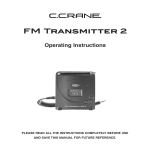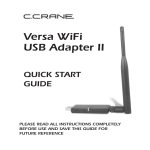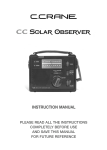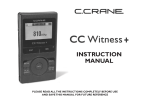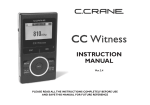Download C. Crane FM Transmitter Operating instructions
Transcript
FM T r a n s m i t t e r Operating Instructions PLEASE READ ALL THE INSTRUCTIONS COMPLETELY BEFORE USE AND SAVE THIS MANUAL FOR FUTURE REFERENCE. Custom Manufactured By Before Use Please read IMPORTANT SAFETY INSTRUCTIONS on pages 13 - 14 before use. It is important to read and understand all instructions. For your future reference: Serial No. (found inside battery compartment) Date of purchase Name and address of dealer Included Accessories: AC Adapter Item Code: FMA Patchcord For Use With RCA Line Out Item Code: FMP Copyright © 2002 by C. Crane Company, Inc., Fortuna, CA 95540 Phone: 1-800-522-8863 Web: ccrane.com All rights reserved. No part of this booklet may be reproduced, in any form or means whatsoever, without permission in writing from C. Crane Company, Inc. Table of Contents Introduction ....................................................................... 4 Audio Sources ................................................................ 4 Location of Controls ..................................................... 6 Connection to Power ..................................................... 7 Battery Installation ........................................................... 7 Tuning ............................................................................... 8 Tips to Make It Work Better .............................................. 9 Troubleshooting Guide ............................................. 10 Safety Instructions .......................................................... 13 Service Information ........................................................ 15 Introduction Thank you for purchasing the FM Transmitter. It transmits high-fidelity audio from any audio source such as Computer, TV, or CD player to any FM radio receiver. Superior engineering and construction techniques were used to bring you the highest quality FM transmitter possible. Never before has this level of performance been available at such a low price. Digital tuning and Phase Lock Loop technology have been incorporated for full FM band frequency coverage, with stability and superb audio quality. Purpose The FM Transmitter is designed to transmit any audio to any FM Receiver. You can transmit satellite audio to any receiver or car stereo, transmit Internet audio from your computer to your portable radio, and also transmit audio from your MP3 player to your home stereo or car. Audio Sources From your computer to your home stereo: Connect the plug that is attached to the FM Transmitter to the headphone jack on your speakers or to the audio output of the computer’s sound card. Tune your receiver to the transmitting frequency. From a Satellite Receiver To Your Car or Home Stereo: Connect the plug that is attached to the FM Transmitter to the Line Out jack of the receiver. Tune your radio or car stereo to the transmitting frequency. Page 4 FM Transmitter Audio Sources (Cont.) From MP3 to a radio: Connect the plug that is attached to the FM Transmitter to the Line Out or headphone jack of the MP3 player. Tune your radio or car stereo to the transmitting frequency. From a portable radio to a pocket radio: Connect the plug that is attached to the FM Transmitter to the Line Out or headphone jack of your radio. Tune your pocket radio to the transmitting frequency. This is sometimes good for office or warehouse environments where reception is only available in a window or other specific location. From a portable CD player to your car stereo: Connect the plug that is attached to the FM Transmitter to the Line Out or headphone jack of the CD player. Tune your car stereo to the transmitting frequency. FM Transmitter Page 5 Location of Controls 7 1 2 3 6 4 5 Control Identification 1) Power Button/Timer 5) Frequency Display 2) Audio Input Indicator 6) DC Input Jack 3) Input Level Control 7) Telescopic Antenna 4) Up/Down Tuning Page 6 FM Transmitter Connection to Power The FM Transmitter will operate on the included AC adapter. It will also operate on the included (2) “AA” size Alkaline batteries. . Battery Installation 1) Open the cover by pushing down on the textured tab firmly and pushing the cover off toward the side of the unit, the same direction the textured arrow is pointing. 2) Insert the (2) “AA” batteries into the compartment as indicated in the drawing below. Be sure the negative (-) end is against the spring. Refer to the drawing below to insure correct installation of your batteries. FM Transmitter Page 7 Tuning To transmit audio from the FM Transmitter, you need to find a clear FM frequency that is not being broadcast on and free from interference. 1) Start with a radio and scan through the entire FM band (using a digital radio, will be easiest). You are looking for the largest gap in between stations. Once you find a gap, select a frequency located somewhere in the middle. Example: There are no stations broadcasting between 90.1 - 93.5, select 91.5. Preferably there won’t be a station broadcasting on either side of the frequency you have selected. 2) Now on your FM Transmitter, turn the power on. Use the up or down tuning arrows to select the same frequency as on your radio. Hold the arrows down for faster tuning. 3) With the FM Transmitter plugged into the radio or other audio source, make sure you have adequate volume. The red LED light indicates there is too much volume. Adjust the input level control on the side of the unit or adjust the volume of your audio source until the light goes off. (Refer to page 6 for location of controls.) Too much audio may cause distortion. Notes On Tuning If you are using a needle and dial radio, tune the transmitter to the general vicinity of where you think you are on your radio. Because you can’t match the frequency exactly, you may need to fine tune your radio to the frequency. If you have a second radio to plug the FM Transmitter into, you can tune the FM Transmitter until you can get the clearest signal on your first radio. Antenna Orientation Start with the antenna straight up and fully extended. You can then orientate the antenna to help transmit the signal a certain direction. Page 8 FM Transmitter Tips To Make It Work Better Location Optimum placement for the FM Transmitter is away from other electronic devices. The higher the transmitter is located the better. Keep metal objects away from the telescopic antenna (meaning not touching or within 2” of the antenna). The transmitter can be helped by placing it on something that will act as a ground plane like a metal filing cabinet or a refrigerator. Range is subject to many variables. The approximate range, line of sight with no obstructions, is about 70 feet. If you are not getting this range, please call us at 1-800-522-8863. Auto Shut-Off The “Auto Shut-Off” will not work until you activate it. Press and hold the power button down, the words Auto-OFF will appear on the display and the transmitter will start to cycle through the available shut-off times. You can choose from 1, 2, 3, 4 or 8 HR shut-off times. If you miss the time you want, just keep holding the button down and it will start over. To select your time let go of the button. Turning the power off and back on clears the auto shut-off. FM Transmitter Page 9 Trouble Shooting Guide Audio is distorted: Try adjusting the input level on the side of the FM Transmitter. If that doesn’t help, try adjusting the volume of your audio source. No Audio: 1) Verify the power on the FM Transmitter, your audio source and your receiver is on. 2) Try adjusting the input level on the side of the FM Transmitter. If that doesn’t help, try adjusting the volume of your audio source. 3) Check your cable and make sure it is connected to the right audio source. 4) Check your frequency and make sure you are tuned to the correct frequency. If none of the above options work, try the FM Transmitter on another device. Page 10 FM Transmitter Location / Frequency Log If you use the FM Transmitter in multiple locations, this log will help you remember the different frequency settings. Location FM Transmitter Frequency Page 11 Notes Page 12 FM Transmitter Safety Instructions READ BEFORE OPERATING EQUIPMENT SAVE THESE INSTRUCTIONS 1) Read and understand all safety and operating instructions before the FM Transmitter is operated. 2) Retain Instructions: The safety and operating instructions should be retained for future reference. 3) Heed Warnings: All warnings on this appliance and all operating instructions should be followed. 4) Water and Moisture: The FM Transmitter should not be used near water. Do not use near a bathtub, washbowl, laundry tub, kitchen sink, wet basement, swimming pool, etc. Risk of electric shock may result. 5) Unplug the FM Transmitter from the DC power adapter before cleaning. Only use a damp cloth for cleaning the exterior surfaces of the transmitter. 6) Do not place the FM Transmitter on an unstable cart, stand, bracket or table. The transmitter may fall, causing serious personal injury and or damage to the transmitter may result. 7) Heat: Never put the FM Transmitter in direct sunlight in an unventilated area or behind glass such as a car's interior. The transmitter should be kept away from heat sources such as radiators, heat registers, stoves, or other appliances that produce heat. 8) DC wall Adapter: The DC wall adapter should be positioned so it is not walked on, pinched, or items placed on top of it. All power and other cables should be routed away from walkways or areas of foot traffic to avoid being tripped on. Always unplug the DC power adapter by gripping the adapter unit and pulling it out of the wall socket. Never pull on the cord. Always operate the FM Transmitter using the correct supplied DC wall adapter. Adapters that are not correctly rated can damage the transmitter. If you are not sure of the correct DC wall adapter, consult your dealer. 9) Never insert objects of any kind into the FM Transmitter through openings. The objects may touch dangerous voltage points or short out parts causing damage to the transmitter. FM Transmitter Page 13 Safety Instructions 10) If the transmitter is stored for long periods of time, unplug it from the wall outlet and remove the batteries. This will prevent damage caused by lightning or power line surges and battery acid from old batteries leaking inside of the transmitter. 11) Never attempt to service the FM Transmitter yourself. Removing the cover may expose you to dangerous voltage levels and will void the warranty. Refer all servicing to authorized service personnel. 12) The FM Transmitter should be serviced by qualified service personnel when: a) Objects have fallen or liquid has been spilled into the transmitter; b) The transmitter has been exposed to rain; c) The transmitter does not appear to operate normally or exhibits a marked change in performance; or d) The transmitter has been dropped or the enclosure damaged. 13) If liquid leaks into the transmitter, do not turn it on. The interior of the transmitter must be fully dry or it will be damaged when power is applied. 14) The user should not attempt to service this transmitter beyond that described in the operating instructions. All other servicing should be referred to qualified service personnel. The symbols below are to alert you to important operation or servicing instructions that may appear in the owner's manual. Page 14 FM Transmitter Safety Instructions This symbol is intended to alert you to the presence of uninsulated dangerous voltage within the product’s enclosure that might be of sufficient magnitude to constitute a risk of electric shock. Do not open the product’s case. Warning: To reduce the risk of fire or shock hazard, do not expose this product to rain or moisture. CAUTION RISK OF ELECTRIC SHOCK. DO NOT OPEN This symbol is intended to inform you that important operating and maintenance instructions are included in the literature accompanying this product. CAUTION: TO REDUCE THE RISK OF ELECTRIC SHOCK, DO NOT REMOVE COVER OR BACK. NO USER-SERVICEABLE PARTS INSIDE. REFER SERVICING TO QUALIFIED PERSONNEL Service Information If your unit requires service call C. Crane Company at 1-800-522-8863. FM Transmitter Page 15 Model: FM TRANSMITTER THIS DEVICE COMPLIES WITH PART 15 OF THE FCC RULES. OPERATION IS SUBJECT TO THE FOLLOWING TWO CONDITIONS. 1) THIS DEVICE MAY NOT CAUSE HARMFUL INTERFERENCE, AND 2) THIS DEVICE MUST ACCEPT ANY INTERFERENCE RECEIVED, INCLUDING INTERFERENCE THAT MAY CAUSE UNDESIRED OPERATION. Notice: The changes or modifications not expressly approved by the party responsible for compliance could void the user’s authority to operate the equipment. 381C15SA






















